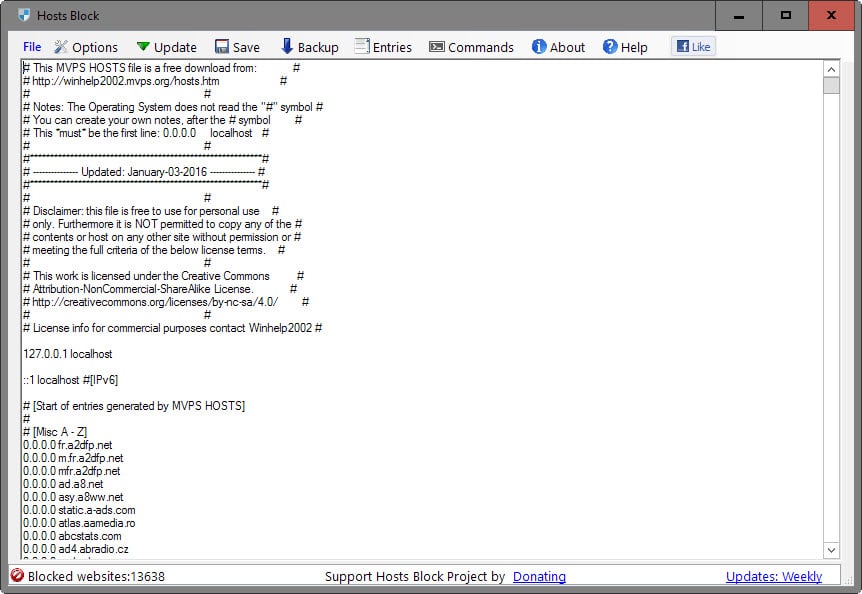Hosts File Entries To Block Adobe Activation Servers
Ruscapturedboys login. There are so many sites out there you do not want either your employees or your family to see. There are also equally as many ways to stop those sites from being viewed - from a simple third-party software solution to one involving a hardware proxy. But did you know, there is a very simple solution built right into, which allows you to block unwanted sites from being viewed on a PC? That solution is the hosts file.
The script will reset your hosts file with the proper Adobe servers. Everyone (including people who have blocked Adobe before) stands to benefit from a clean, properly edited hosts file. If you need to preserve extra entries, you can do that too, the script is flexible. How To Disable Adobe PhotoShop CS5 Internet Update Manager. To block the software you will need to edit the Windows host file. The hosts file is a computer file used in an. Line at the end of the file: 127.0.0.1 activate.adobe.com.
Simply stated, the Windows hosts file is used to map IP addresses to Human Readable Names. This service is normally handled with a domain name server (DNS), but the hosts file allows you to bypass that server (When, say DNS isn't available).

But more importantly, the hosts file is in direct control of what the computer can and cannot see. To this end, a PC can be configured such that it can or cannot see a specific address.
That is what I want to address - the blocking of unwanted addresses in the Windows hosts file. This blog post is also available in the PDF format in a. The examples and images used in this blog post regard Windows 7. The hosts file in earlier versions of Windows can be used in a similar fashion, but the configuration may not be exactly the same. Locating and editing the hosts file The Windows hosts file is located ( Figure A) in C: Windows System32 drivers etc.
After Extracting you will be able to see the following files: Step 5: Now Open Flash_tool.exe (you will find this from the extracted files in Step#6). Install doro usb phone suite installation. Step 2: Power Off your Android Smartphone and remove the Battery (if it is removable). Step 6: Once Smart Phone Flash Tool is launched, Click on the Download Tab. Step 4: Download and Extract Smart Phone Flash Tool on Your Computer. Step 3: Download the Stock Rom or Custom Rom that you want to Flash on your Android Smartphone and extract it on your Computer.
In order to edit and save the hosts file, administrative rights must be used. Even if a user is logged into an account without administrative privileges, this can be overcome, by following these steps: 1. Click on Start All Programs Accessories. Select Run as Administrator 4.
Click Yes on the popup window Figure A Location of hosts file Now that Notepad is opened with administrative rights, the hosts file can be opened and edited. There could be one last hiccup in the saving of the hosts file - the hosts file could be set to read-only. If this is the case, that file cannot be edited and saved. To get around this, follow these steps: 1. Right-click the hosts file from within Windows Explorer 2. Select Properties 3.
Uncheck Read-only ( Figure B) 4. Click Yes in the UAC (if prompted) 5. Click OK in the Properties window to complete the process Figure B Uncheck read only if it is checked Format of the hosts file The format of the entries in the hosts file looks like this ( Figure C): IP_ADDRESS domain name Figure C Format of the entries in the hosts file That is the basic mapping from IP to domain. Each line represents a single mapping. For example, an internal IP address to a hostname would be made with an entry like this: 192.168.100.21 bodhi-linux Once the file is saved, the machine at the address 192.168.100.21 can be reached using the name bodhi-linux. Blocking Adware and/or unwanted sites This is where the 'trick' comes in. There is an address, called the loopback address, on a computer that refers to itself.
If the loopback address is pinged, the machine being pinged would be the machine doing the pinging. The IP address of the loopback is always 127.0.0.1 (that is the case in Windows, Linux, and Mac.). Using that loopback address, any unwanted domain name can be re-directed back to the local machine.
A hosts file entry for this would look like: 127.0.0.1 unwanted.domain Where unwanted.domain is the domain to be blocked. So what needs to be done with the hosts file is: 1.
Open the hosts file with administrative privileges 2. Add all of the entries you need to block all of the sites you want to block 3. Save the hosts file 4. Reset the hosts file to read-only There is another issue that can rear its ugly head.